Page 456 of 594
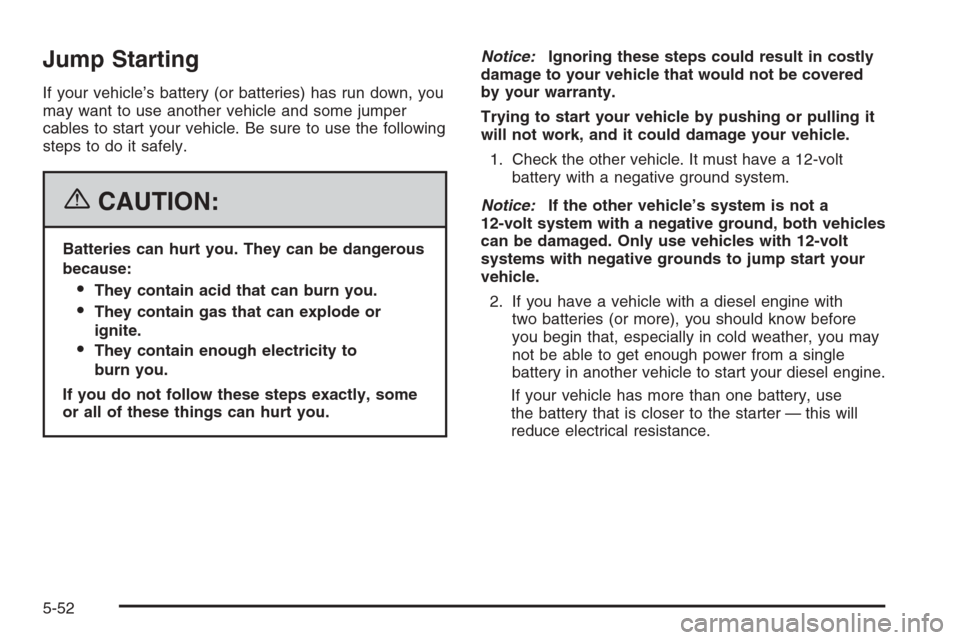
Jump Starting
If your vehicle’s battery (or batteries) has run down, you
may want to use another vehicle and some jumper
cables to start your vehicle. Be sure to use the following
steps to do it safely.
{CAUTION:
Batteries can hurt you. They can be dangerous
because:
They contain acid that can burn you.
They contain gas that can explode or
ignite.
They contain enough electricity to
burn you.
If you do not follow these steps exactly, some
or all of these things can hurt you.Notice:Ignoring these steps could result in costly
damage to your vehicle that would not be covered
by your warranty.
Trying to start your vehicle by pushing or pulling it
will not work, and it could damage your vehicle.
1. Check the other vehicle. It must have a 12-volt
battery with a negative ground system.
Notice:If the other vehicle’s system is not a
12-volt system with a negative ground, both vehicles
can be damaged. Only use vehicles with 12-volt
systems with negative grounds to jump start your
vehicle.
2. If you have a vehicle with a diesel engine with
two batteries (or more), you should know before
you begin that, especially in cold weather, you may
not be able to get enough power from a single
battery in another vehicle to start your diesel engine.
If your vehicle has more than one battery, use
the battery that is closer to the starter — this will
reduce electrical resistance.
5-52
Page 457 of 594
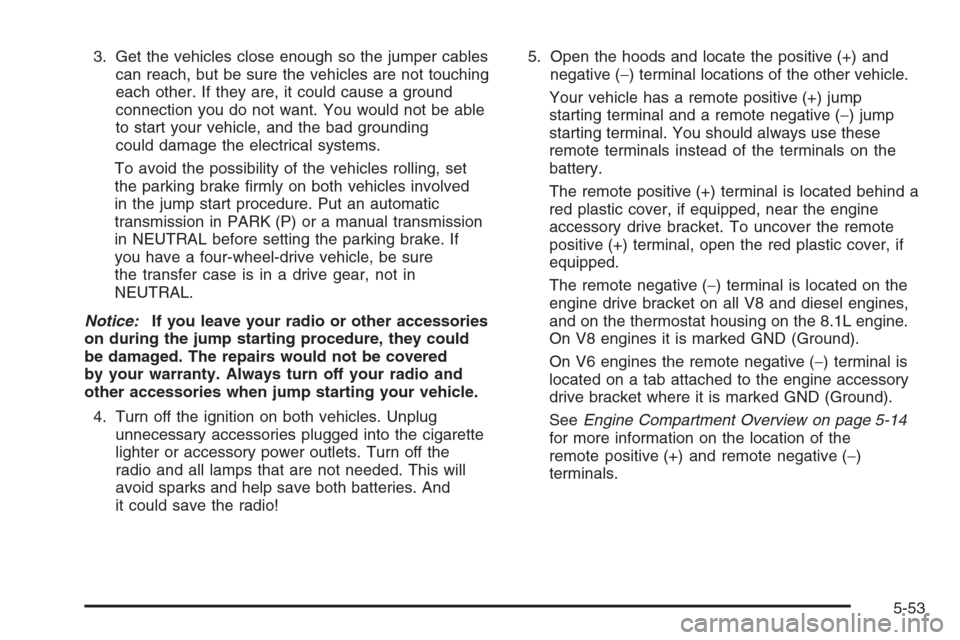
3. Get the vehicles close enough so the jumper cables
can reach, but be sure the vehicles are not touching
each other. If they are, it could cause a ground
connection you do not want. You would not be able
to start your vehicle, and the bad grounding
could damage the electrical systems.
To avoid the possibility of the vehicles rolling, set
the parking brake �rmly on both vehicles involved
in the jump start procedure. Put an automatic
transmission in PARK (P) or a manual transmission
in NEUTRAL before setting the parking brake. If
you have a four-wheel-drive vehicle, be sure
the transfer case is in a drive gear, not in
NEUTRAL.
Notice:If you leave your radio or other accessories
on during the jump starting procedure, they could
be damaged. The repairs would not be covered
by your warranty. Always turn off your radio and
other accessories when jump starting your vehicle.
4. Turn off the ignition on both vehicles. Unplug
unnecessary accessories plugged into the cigarette
lighter or accessory power outlets. Turn off the
radio and all lamps that are not needed. This will
avoid sparks and help save both batteries. And
it could save the radio!5. Open the hoods and locate the positive (+) and
negative (−) terminal locations of the other vehicle.
Your vehicle has a remote positive (+) jump
starting terminal and a remote negative (−) jump
starting terminal. You should always use these
remote terminals instead of the terminals on the
battery.
The remote positive (+) terminal is located behind a
red plastic cover, if equipped, near the engine
accessory drive bracket. To uncover the remote
positive (+) terminal, open the red plastic cover, if
equipped.
The remote negative (−) terminal is located on the
engine drive bracket on all V8 and diesel engines,
and on the thermostat housing on the 8.1L engine.
On V8 engines it is marked GND (Ground).
On V6 engines the remote negative (−) terminal is
located on a tab attached to the engine accessory
drive bracket where it is marked GND (Ground).
SeeEngine Compartment Overview on page 5-14
for more information on the location of the
remote positive (+) and remote negative (−)
terminals.
5-53
Page 458 of 594
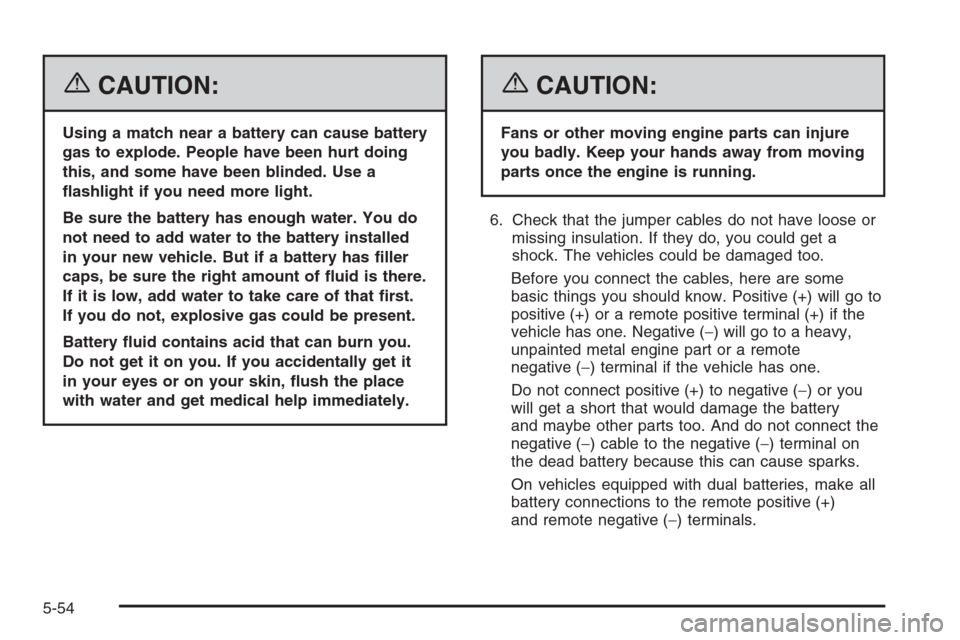
{CAUTION:
Using a match near a battery can cause battery
gas to explode. People have been hurt doing
this, and some have been blinded. Use a
�ashlight if you need more light.
Be sure the battery has enough water. You do
not need to add water to the battery installed
in your new vehicle. But if a battery has �ller
caps, be sure the right amount of �uid is there.
If it is low, add water to take care of that �rst.
If you do not, explosive gas could be present.
Battery �uid contains acid that can burn you.
Do not get it on you. If you accidentally get it
in your eyes or on your skin, �ush the place
with water and get medical help immediately.
{CAUTION:
Fans or other moving engine parts can injure
you badly. Keep your hands away from moving
parts once the engine is running.
6. Check that the jumper cables do not have loose or
missing insulation. If they do, you could get a
shock. The vehicles could be damaged too.
Before you connect the cables, here are some
basic things you should know. Positive (+) will go to
positive (+) or a remote positive terminal (+) if the
vehicle has one. Negative (−) will go to a heavy,
unpainted metal engine part or a remote
negative (−) terminal if the vehicle has one.
Do not connect positive (+) to negative (−)oryou
will get a short that would damage the battery
and maybe other parts too. And do not connect the
negative (−) cable to the negative (−) terminal on
the dead battery because this can cause sparks.
On vehicles equipped with dual batteries, make all
battery connections to the remote positive (+)
and remote negative (−) terminals.
5-54
Page 459 of 594
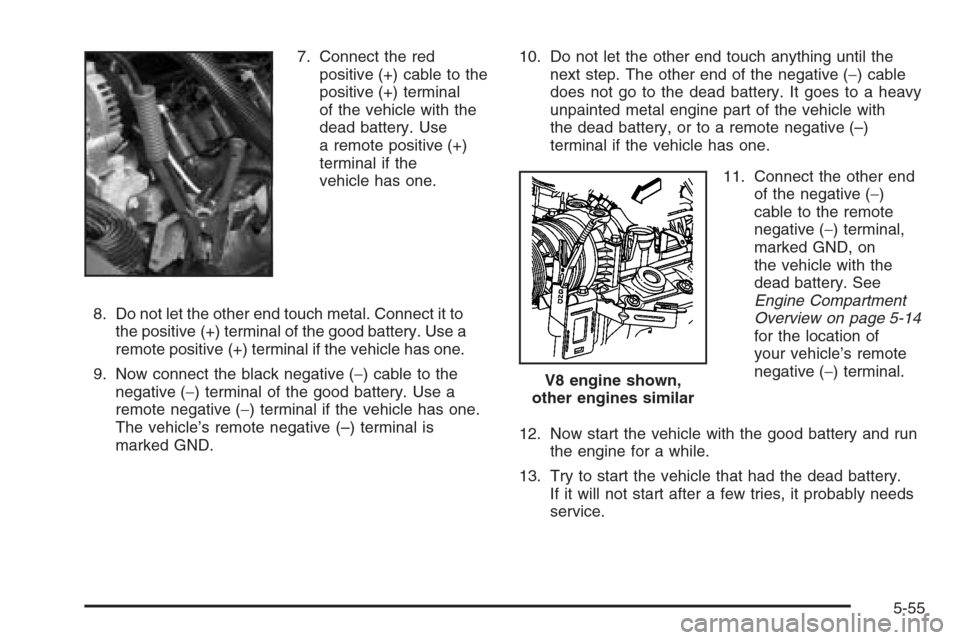
7. Connect the red
positive (+) cable to the
positive (+) terminal
of the vehicle with the
dead battery. Use
a remote positive (+)
terminal if the
vehicle has one.
8. Do not let the other end touch metal. Connect it to
the positive (+) terminal of the good battery. Use a
remote positive (+) terminal if the vehicle has one.
9. Now connect the black negative (−) cable to the
negative (−) terminal of the good battery. Use a
remote negative (−) terminal if the vehicle has one.
The vehicle’s remote negative (–) terminal is
marked GND.10. Do not let the other end touch anything until the
next step. The other end of the negative (−) cable
does not go to the dead battery. It goes to a heavy
unpainted metal engine part of the vehicle with
the dead battery, or to a remote negative (–)
terminal if the vehicle has one.
11. Connect the other end
of the negative (−)
cable to the remote
negative (−) terminal,
marked GND, on
the vehicle with the
dead battery. See
Engine Compartment
Overview on page 5-14
for the location of
your vehicle’s remote
negative (−) terminal.
12. Now start the vehicle with the good battery and run
the engine for a while.
13. Try to start the vehicle that had the dead battery.
If it will not start after a few tries, it probably needs
service.
V8 engine shown,
other engines similar
5-55
Page 460 of 594
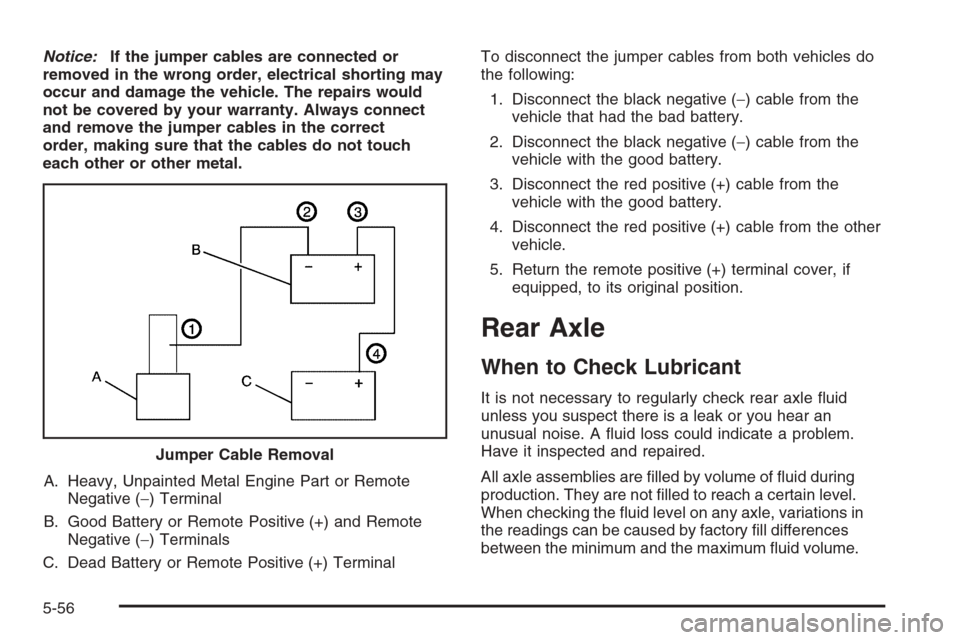
Notice:If the jumper cables are connected or
removed in the wrong order, electrical shorting may
occur and damage the vehicle. The repairs would
not be covered by your warranty. Always connect
and remove the jumper cables in the correct
order, making sure that the cables do not touch
each other or other metal.
A. Heavy, Unpainted Metal Engine Part or Remote
Negative (−) Terminal
B. Good Battery or Remote Positive (+) and Remote
Negative (−) Terminals
C. Dead Battery or Remote Positive (+) TerminalTo disconnect the jumper cables from both vehicles do
the following:
1. Disconnect the black negative (−) cable from the
vehicle that had the bad battery.
2. Disconnect the black negative (−) cable from the
vehicle with the good battery.
3. Disconnect the red positive (+) cable from the
vehicle with the good battery.
4. Disconnect the red positive (+) cable from the other
vehicle.
5. Return the remote positive (+) terminal cover, if
equipped, to its original position.
Rear Axle
When to Check Lubricant
It is not necessary to regularly check rear axle �uid
unless you suspect there is a leak or you hear an
unusual noise. A �uid loss could indicate a problem.
Have it inspected and repaired.
All axle assemblies are �lled by volume of �uid during
production. They are not �lled to reach a certain level.
When checking the �uid level on any axle, variations in
the readings can be caused by factory �ll differences
between the minimum and the maximum �uid volume. Jumper Cable Removal
5-56
Page 461 of 594
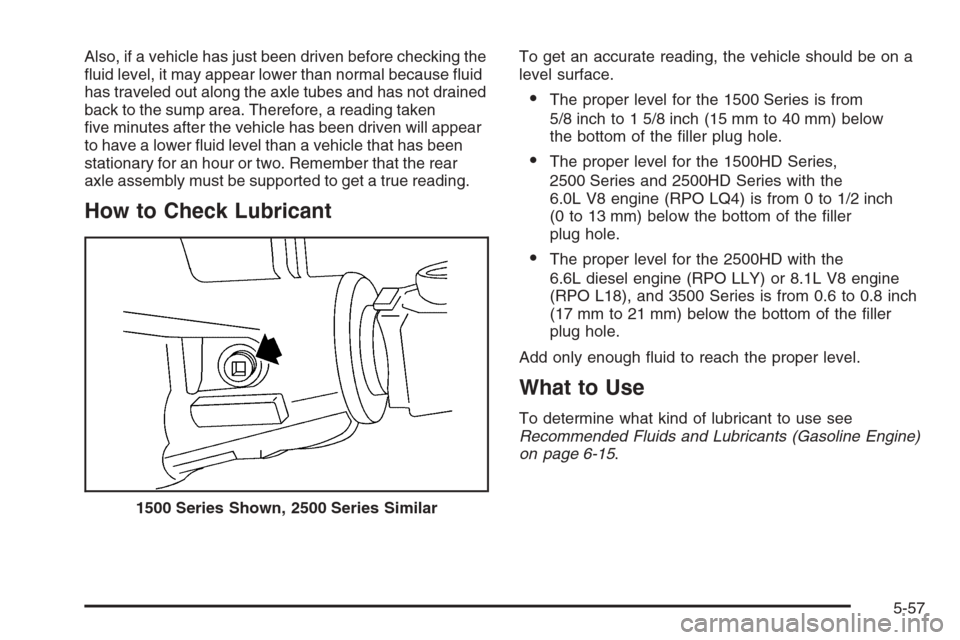
Also, if a vehicle has just been driven before checking the
�uid level, it may appear lower than normal because �uid
has traveled out along the axle tubes and has not drained
back to the sump area. Therefore, a reading taken
�ve minutes after the vehicle has been driven will appear
to have a lower �uid level than a vehicle that has been
stationary for an hour or two. Remember that the rear
axle assembly must be supported to get a true reading.
How to Check Lubricant
To get an accurate reading, the vehicle should be on a
level surface.
The proper level for the 1500 Series is from
5/8 inch to 1 5/8 inch (15 mm to 40 mm) below
the bottom of the �ller plug hole.
The proper level for the 1500HD Series,
2500 Series and 2500HD Series with the
6.0L V8 engine (RPO LQ4) is from 0 to 1/2 inch
(0 to 13 mm) below the bottom of the �ller
plug hole.
The proper level for the 2500HD with the
6.6L diesel engine (RPO LLY) or 8.1L V8 engine
(RPO L18), and 3500 Series is from 0.6 to 0.8 inch
(17 mm to 21 mm) below the bottom of the �ller
plug hole.
Add only enough �uid to reach the proper level.
What to Use
To determine what kind of lubricant to use see
Recommended Fluids and Lubricants (Gasoline Engine)
on page 6-15.
1500 Series Shown, 2500 Series Similar
5-57
Page 463 of 594
To get an accurate reading, the vehicle should be on a
level surface.
If the level is below the bottom of the �ller plug hole,
located on the transfer case, you’ll need to add
some lubricant. Add enough lubricant to raise the level
to the bottom of the �ller plug hole. Use care not to
overtighten the plug.
When to Change Lubricant
Refer to the Maintenance Schedule to determine how
often to change the lubricant. SeeScheduled
Maintenance (Gasoline Engine) on page 6-4.
What to Use
Refer to the Maintenance Schedule to determine what
kind of lubricant to use. SeeRecommended Fluids
and Lubricants (Gasoline Engine) on page 6-15.
Automatic Transfer Case
5-59
Page 464 of 594
Front Axle
When to Check Lubricant
It is not necessary to regularly check front axle �uid
unless you suspect there is a leak or you hear an
unusual noise. A �uid loss could indicate a problem.
Have it inspected and repaired.
How to Check Lubricant
To get an accurate reading, the vehicle should be on a
level surface.
If the level is below the bottom of the �ller plug hole,
located on the front axle, you may need to add
some lubricant:
When the differential is cold, add enough lubricant
to raise the level to 0 to 3/8 inch (9.5 mm) below
the �ller plug hole.
When the differential is at operating temperature
(warm), add enough lubricant to raise the level
to the bottom of the �ller plug hole.
What to Use
To determine what kind of lubricant to use see
Recommended Fluids and Lubricants (Gasoline Engine)
on page 6-15.
5-60